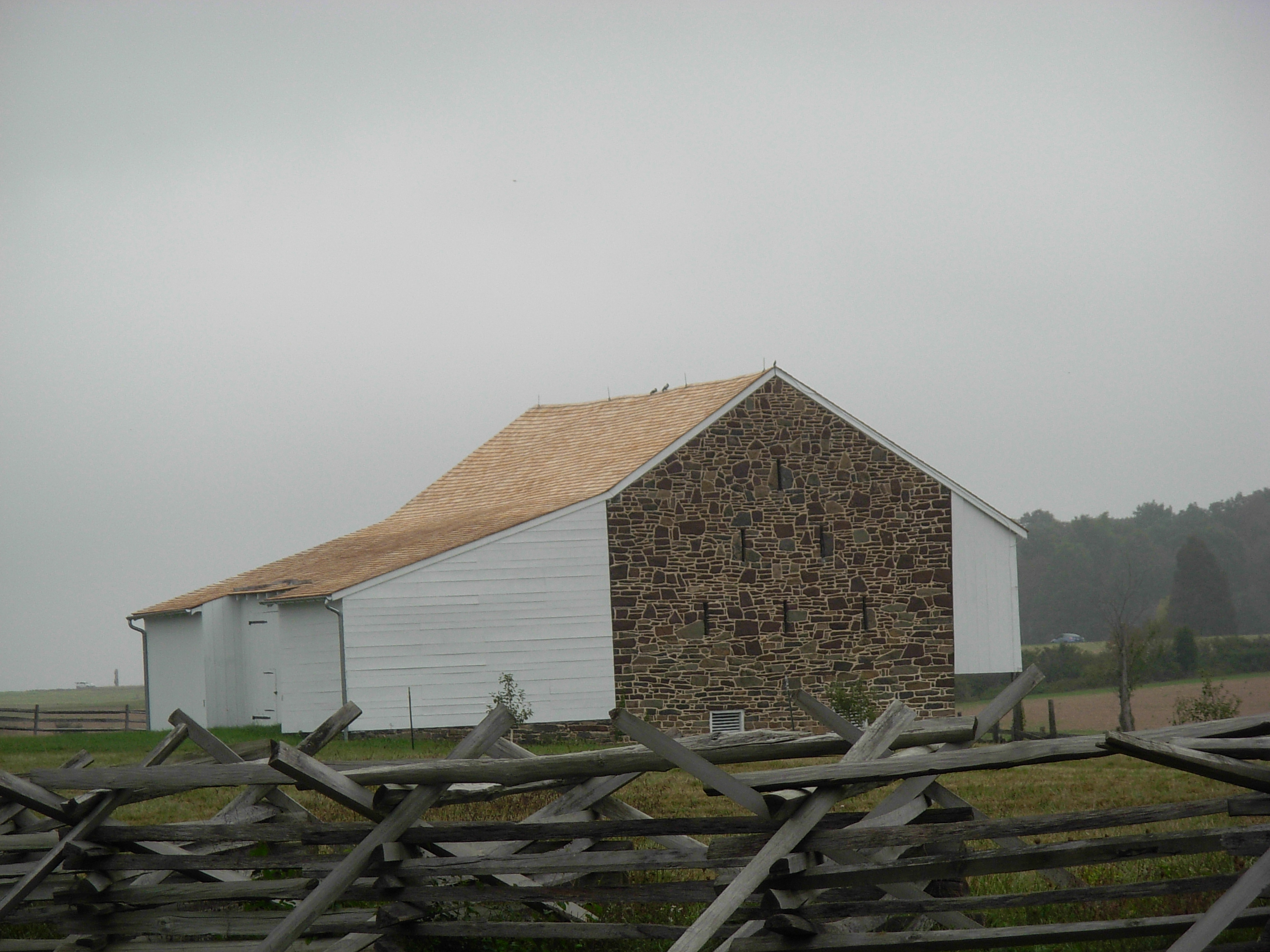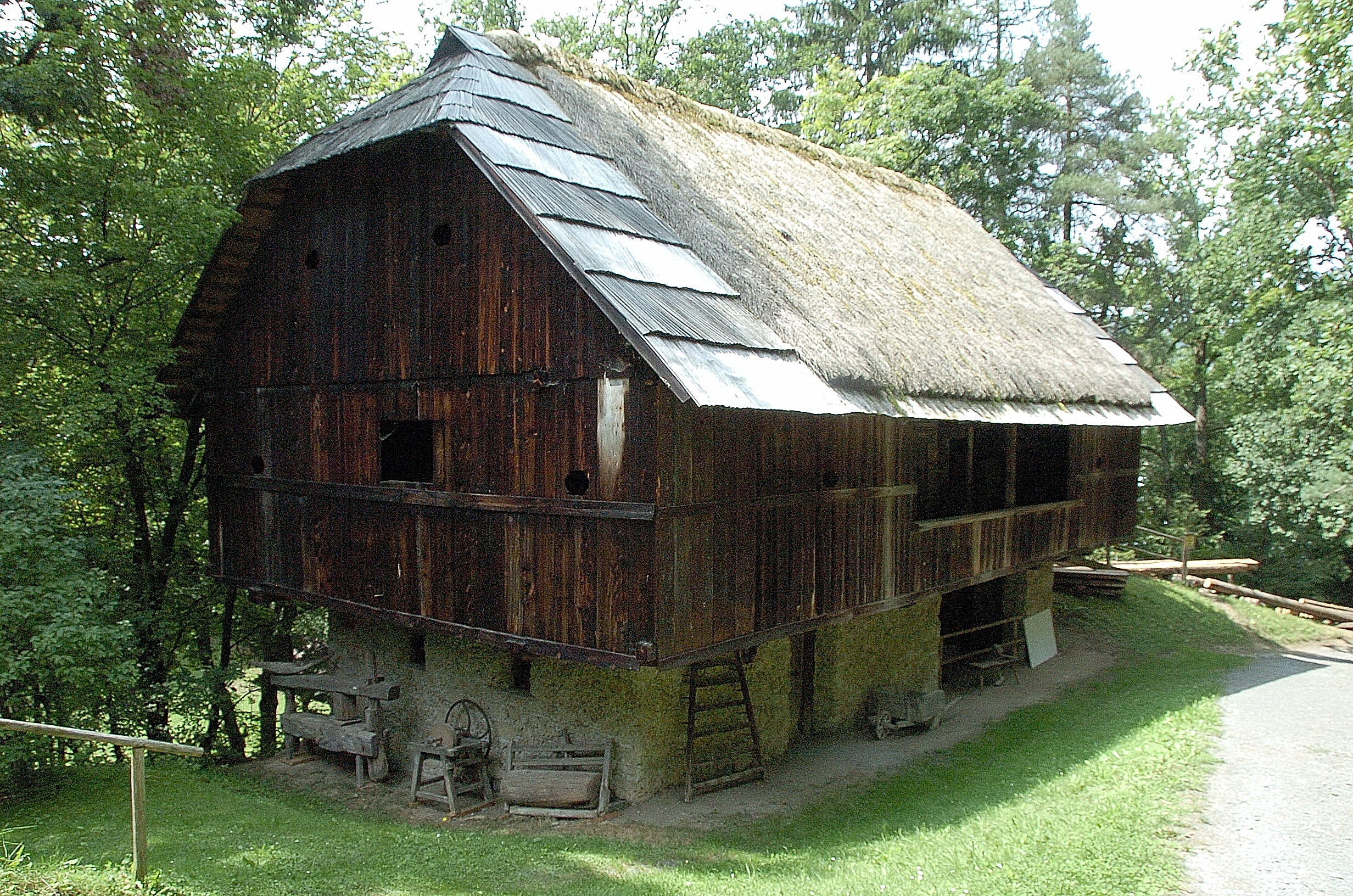Pennsylvania Bank Barn on:
[Wikipedia]
[Google]
[Amazon]
 A Pennsylvania barn is a type of banked barn built in the US from about 1790 to 1900. The style's most distinguishing feature is the presence of an overshoot or forebay, an area where one or more walls overshoot its foundation. These barns were banked, that is set into a hillside to ensure easy access to both the
A Pennsylvania barn is a type of banked barn built in the US from about 1790 to 1900. The style's most distinguishing feature is the presence of an overshoot or forebay, an area where one or more walls overshoot its foundation. These barns were banked, that is set into a hillside to ensure easy access to both the
, ''Agricultural Architecture Field Guide'', Pennsylvania Historical & Museum Commission. Retrieved 9 February 2007. Barn scholar Robert Ensminger classified the Pennsylvania barn into three types: Standard Pennsylvania, Sweitzer, and Extended Pennsylvania barns.Ensminger, Robert F. ''The Pennsylvania barn: its origin, evolution, and distribution in North America''. 2nd ed. Baltimore: Johns Hopkins University Press, 2003. The Pennsylvania-style barns were also built in the
 Sweitzer barns are also known as Swetzer or Swisser. The name reflects the barn's probable origin from Switzerland. The Sweitzer is the "original Pennsylvania barn"; it was originally a log crib-type barn built between 1730 and 1850. The distinguishing feature of this type of forebay barn is that the forebay projects in a way that the gable end is asymmetrical.
Sweitzer barns are also known as Swetzer or Swisser. The name reflects the barn's probable origin from Switzerland. The Sweitzer is the "original Pennsylvania barn"; it was originally a log crib-type barn built between 1730 and 1850. The distinguishing feature of this type of forebay barn is that the forebay projects in a way that the gable end is asymmetrical.
 As agricultural productivity increased, the Standard Pennsylvania barn was not large enough, and this third class of barn was developed first by adding on to the Standard barn. New barns were based on the Standard but with more space added to the forebay side, ramp side, or by being made taller and adding another floor (storey) level.
As agricultural productivity increased, the Standard Pennsylvania barn was not large enough, and this third class of barn was developed first by adding on to the Standard barn. New barns were based on the Standard but with more space added to the forebay side, ramp side, or by being made taller and adding another floor (storey) level.
 * Charles Harris Whitaker, "Some Thoughts About Barns", ''Journal of the American Institute of Architects'', October 1924
* Charles Harris Whitaker, "Some Thoughts About Barns", ''Journal of the American Institute of Architects'', October 1924
Photo and information about Sweitzer barns
Farm Building Guide
Historic Barn & Farm Foundation of Pennsylvania
Barns in the United States Timber framed buildings
basement
A basement or cellar is one or more floors of a building that are completely or partly below the ground floor. It generally is used as a utility space for a building, where such items as the furnace, water heater, breaker panel or fuse box, ...
and the level above. Almost all Pennsylvania barns also have gable
A gable is the generally triangular portion of a wall between the edges of intersecting roof pitches. The shape of the gable and how it is detailed depends on the structural system used, which reflects climate, material availability, and aesth ...
roofs."Pennsylvania Barns", ''Agricultural Architecture Field Guide'', Pennsylvania Historical & Museum Commission. Retrieved 9 February 2007. Barn scholar Robert Ensminger classified the Pennsylvania barn into three types: Standard Pennsylvania, Sweitzer, and Extended Pennsylvania barns.Ensminger, Robert F. ''The Pennsylvania barn: its origin, evolution, and distribution in North America''. 2nd ed. Baltimore: Johns Hopkins University Press, 2003. The Pennsylvania-style barns were also built in the
Shenandoah Valley
The Shenandoah Valley () is a geographic valley and cultural region of western Virginia and the Eastern Panhandle of West Virginia. The valley is bounded to the east by the Blue Ridge Mountains, to the west by the eastern front of the Ridge- ...
, as well as west of Pennsylvania and in Canada.
Standard Pennsylvania barn
"The Standard Pennsylvania barn is the most numerous and widely distributed class of the Pennsylvania barns." These were built between 1790 and 1890. The key characteristic in identifying this type is the forebay, which is built so that the gable end is symmetrical, with both front and rear walls being the same height.Sweitzer barn
 Sweitzer barns are also known as Swetzer or Swisser. The name reflects the barn's probable origin from Switzerland. The Sweitzer is the "original Pennsylvania barn"; it was originally a log crib-type barn built between 1730 and 1850. The distinguishing feature of this type of forebay barn is that the forebay projects in a way that the gable end is asymmetrical.
Sweitzer barns are also known as Swetzer or Swisser. The name reflects the barn's probable origin from Switzerland. The Sweitzer is the "original Pennsylvania barn"; it was originally a log crib-type barn built between 1730 and 1850. The distinguishing feature of this type of forebay barn is that the forebay projects in a way that the gable end is asymmetrical.
Extended Pennsylvania barn
References
{{Reflist * Charles Harris Whitaker, "Some Thoughts About Barns", ''Journal of the American Institute of Architects'', October 1924
* Charles Harris Whitaker, "Some Thoughts About Barns", ''Journal of the American Institute of Architects'', October 1924
External links
Photo and information about Sweitzer barns
Farm Building Guide
Historic Barn & Farm Foundation of Pennsylvania
Barns in the United States Timber framed buildings